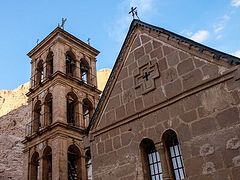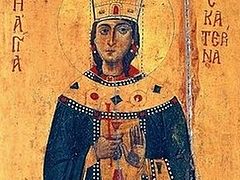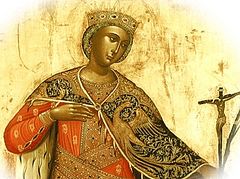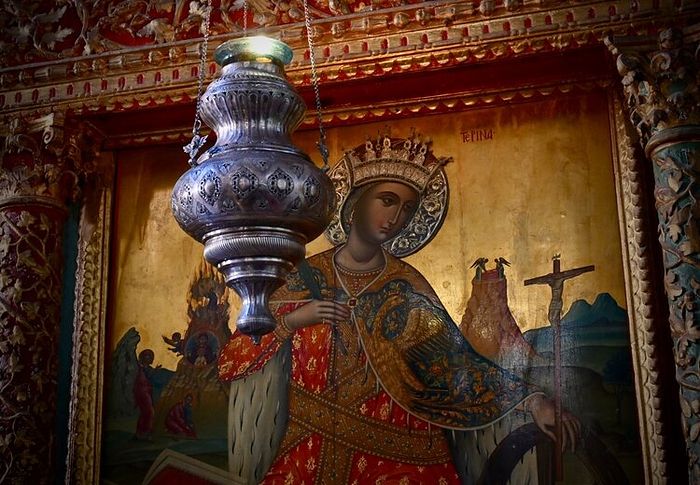 On the iconostasis of the Monastery basilica following Divine Liturgy on November 21, 2019, Saint Catherine contemplates the love with which the crucified Christ restores humanity to Himself
On the iconostasis of the Monastery basilica following Divine Liturgy on November 21, 2019, Saint Catherine contemplates the love with which the crucified Christ restores humanity to Himself
How does modern culture come to grips with the sacrifices of the Great Martyrs whose legacy refuses to go away? Their names identify not only our humble selves, but the cities, schools and hospitals on our maps, while tours of the great European capitals find the secular-minded in more churches in a week than they imagined visiting in a lifetime …
Northern Europeans, for their part, come down to Greece starved for cloudless skies. Surf and sand, bars and bouzoukia, all have their day in the sun. A day or two on the beaches suffices, however, for the novelty of it all to wear thin, revealing the specter of an underlying monotony, one no longer held at bay … The maps come out again, and happily disclose the locations of scenic monasteries within easy range of a morning’s diversion.
Within their cool sanctuaries, however, it becomes even harder to escape the reality of human history, as not only the names of the Martyrs, but their countenances gaze down from their icons as from heaven. The experience is far from a distressing one, however; so far so, that one is not sorry, while later enjoying coffee and a traditional sweet, to open a conversation on what it all means …
After all, what is life without substance?
Welcomed to hearth and heart of a monastery in the special guest room called “the arhontariki” – meaning that guests cross its threshold as nobility – one begins to feel like royalty. Carefully preserved from past centuries of a monastery’s long life, hand-loomed textiles and other artifacts draw memories of a nobler age … while the mystery deepens.
For the young nun likely serving visitors (most monks having escaped further afield to the Holy Mountains of Sinai or Athos) is likely little older than Saint Catherine and other maiden Martyrs condemned for calling out the scandal of idol worship. Powerful leaders of early Christianity – Barbara, Irene, Kyriaki, Eugenia, Paraskevi, and Marina (once venerated on Sinai in a chapel bearing her name) – defy understanding as one struggles to reconcile their tender youth with wisdom beyond compare.
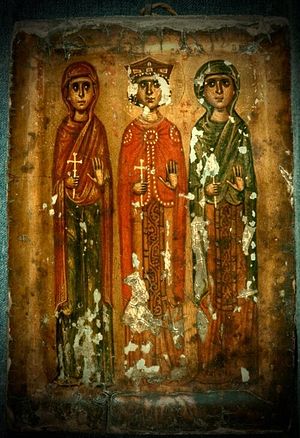 Saints Marina, Catherine, and Barbara, from the Sinai collections Renowned in common for the invincible courage with which each fought the lies of idolatry during times of depraved persecution, the story of Saint Catherine presents yet another marvel. Newly baptized after her search for the meaning of life led from academia to Christ, instead of steeling herself for the moment she would be condemned for speaking truth, Catherine precipitated martyrdom on her own initiative. In about the year 300, without prior threats to life or well-being, she publicly accosted the pagan emperor on a day when the smoke and cries of idolatrous celebration filled the air of Alexandria.
Saints Marina, Catherine, and Barbara, from the Sinai collections Renowned in common for the invincible courage with which each fought the lies of idolatry during times of depraved persecution, the story of Saint Catherine presents yet another marvel. Newly baptized after her search for the meaning of life led from academia to Christ, instead of steeling herself for the moment she would be condemned for speaking truth, Catherine precipitated martyrdom on her own initiative. In about the year 300, without prior threats to life or well-being, she publicly accosted the pagan emperor on a day when the smoke and cries of idolatrous celebration filled the air of Alexandria.
What is the inspiration that could lead an aristocratic young woman to sacrifice all – beauty, education, brilliance, suitors, palaces, wealth, and status – without regret for the loss of their pleasures?
Geronta Pavlos of Sinai once posed the question to a roomful of monastics in the Monastery arhontariki: “When we’re afraid to go to the dentist,” he asked, “how did the Martyrs endure the cruelties they faced?” No one volunteered an answer, and understandably. Who had the right?
But on another occasion, he cracked a window onto the subject. Asked how one can decide whether to act on the inclination to become a monk, he replied that it’s not enough for a person to want this himself; he must also be called by God.
And how does the potential monk know he’s been called by God? “Even if they offer him a princess for a wife, he’s not interested!”
Catherine was not the first noblewoman of Alexandria to refuse princely suitors in favor of the Bridegroom Christ. In the same city, Saint Eugenia, whose father was the governor of Egypt, also embraced baptism as a young woman. Preceding Catherine by half a century, Eugenia then became a monk, disguised as a man with the blessing of the local bishop. Not yet satisfied, apparently, she outdid this by getting elected abbot!
Clearly, the monastic soul knows what it wants, driven by desires transcending anything we can see. Nonetheless, the monk or nun chooses the white martyrdom of obedience, not the red one of his lifeblood. Even so – having promised to sacrifice one’s life in order to find it – all monastics (not only experienced ascetics like Sinai’s Elder Pavlos and Saint Paisios) ask the question: how did the martyrs endure? The question is not academic; many Sinai monastics, like those of later times and places, followed Eugenia, who placed the gift of her pure soul into Christ’s hands on the day of His Nativity, by following white martyrdom with the red.
Neither is it theoretical. Within the past hundred years alone, the Great Martyrs of Holy Russia – monks, nuns, bishops priests, and the holy, anonymous devout – number in the millions …
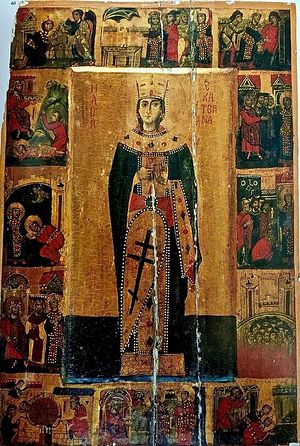 Sinai icon of Saint Catherine with scenes of her martyrdom Regarding involuntary martyrdom, we are assured that God does not give a cross heavier than the bearer can lift. But with respect to the rarer, voluntary martyrdom – the sacrifice of Saint Catherine surpassing word and speech – an Orthodox Christian must have the blessing of his spiritual father. And for a good reason; not all would endure. Better by far to avoid martyrdom, than deny one’s faith in Christ! We do know that Saint Catherine had a trusted spiritual father named Onouphrios whose counsel informed her every step.
Sinai icon of Saint Catherine with scenes of her martyrdom Regarding involuntary martyrdom, we are assured that God does not give a cross heavier than the bearer can lift. But with respect to the rarer, voluntary martyrdom – the sacrifice of Saint Catherine surpassing word and speech – an Orthodox Christian must have the blessing of his spiritual father. And for a good reason; not all would endure. Better by far to avoid martyrdom, than deny one’s faith in Christ! We do know that Saint Catherine had a trusted spiritual father named Onouphrios whose counsel informed her every step.
How then did a young and beautiful woman voluntarily sacrifice the pleasures we hold dearer than life itself?
To be sure, neither worldly pleasures nor pain had any part in creation before the fall, according to Saint Maximos the Confessor. Clothed by the glory of God, the first humans enjoyed a less materialistic existence than our own, we are told. Monastics try to recapture this primordial freedom with a lifestyle free of gender stereotypes, supported mainly by plant-based (and local!) foods, together with the relentless struggle to fast from evil, needs, and even from desires.
But, sounding for all the world like a place of unspoiled pleasures, is not Paradise called the “Garden of Delight” in the Greek scriptures quoted by Jesus Himself?
Saint Maximos, whose writings bear more than a passing consonance with those of Sinai’s Saint John Klimakos, explains the complementary nature of materialistic pleasure and its offspring pain, pinpointing their common origin in the turning of mankind away from its Creator. Disobeying the injunction to fast (the first commandment given to humans), Adam and Eve looked elsewhere for prosperity. But fasting from certain foods was provided by God as means to a greater good – communion in His love, by demonstrating trust in it. Surely they had plenty of other things to eat?
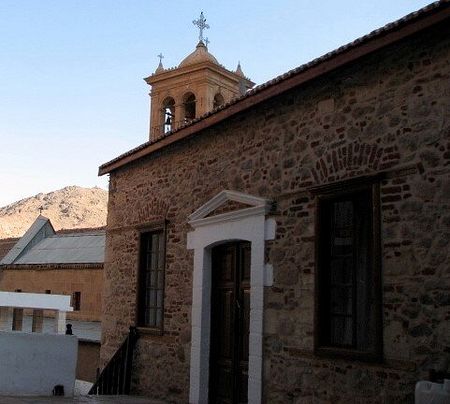 St. Catherine’s arxontariki hosts monks and pilgrims for spiritual fellowship following the divine services
St. Catherine’s arxontariki hosts monks and pilgrims for spiritual fellowship following the divine services
Instituted with the Creation itself, fasting proves to be the ultimate act of thanksgiving that unites us to the body and blood of God – for Christ becomes material just as humans become divine. Spurning this immeasurable gift of communion in God, the first humans exchanged the blessing of God for that of a “grass-eating ox” – the pleasures of the stomach.
What was their elemental mistake? Created to prosper by loving God first, above all else – man chooses instead to love himself first. Placing his will over the loving commandment of God, he makes a tragic decision.
How many Christians today follow suit, repeating the same refusal to fast that cast Adam and Eve out of Paradise … while calling it thanksgiving to God?
No one can serve two masters, Christ said. Either he will hate the one and love the other, or he will hold to the one and despise the other. Making material pleasures the target of his love, man’s imagined self-sufficiency ends in grief. “For every good and perfect gift is from above, coming down from You, the Father of lights….”
It was Plato who noted that, of all the five basic senses, only vision cannot function independently. If the eye which is the lamp of the body remains disabled without light, what do the eyes of our innermost soul see, deprived of the light of Christ? Was not the soul created as the vessel of His radiance? … When Orthodox peoples were forced to leave their homelands for the western hemisphere, was this not allowed by Christ in order for them to shed the light of His Truth on its prevailing darkness?
Is there a soul alive that does not thirst for the truth, with which to gorge itself on the light of understanding?
Most Orthodox who arrived on American shores did not shoulder advanced degrees in theology with their baggage through Ellis Island. But they filled their new cities with the historic faith of authentic Christianity. Without doubt they knew the subject better than the bustling society at their feet, because they knew the ancient services. Of course the greatest teacher of theology is the Divine Liturgy, in which the Word of God Himself enlightens His people … assisted by the Saints whose monasteries Greek villagers thought nothing of walking miles to reach on the eves of their Feast days. Entire villages would travel on foot laden with oil for the church lamps and other gifts to the glory of God. Children never forgot the hushed hours spent on the floors of celebrating churches in anticipation of morning Liturgy, nights illumined by the unforgettable gaze of sanctity emanating from holy icons.…
Next time you pass through Thermo on your way to venerate the miraculous icon of Panagia Proussiotissa in Greece’s mountainous Karpenissi, stop by Thermo’s main square and ask to see the church register from 1918. Better yet, follow the icon of Saint Paraskevi through the streets of the town on November 20th, participating in the annual procession marking the one that took place on that date in 1918, when villagers were dying like flies from the flu pandemic that razed 50 million people globally – one fifth of the earth’s population.
Fully one third of the planet was infected with the rampant disease. Three months into the catastrophe, church records list the deaths of two to twelve people per day in Thermo, a bucolic area once famous for tobacco production, now for its rich Greek milk. Contemporary medicine was helpless before an enemy so lethal that many of its victims never even had time to reach a hospital. And if the hospital even existed, what could it offer an age preceding vaccines and modern interventions? But the people of Thermo knew their Saints.
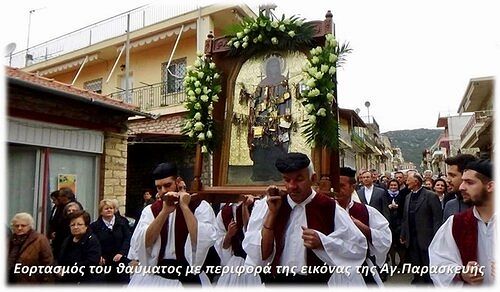 Celebration of the miraculous procession of 1918 when Saint Paraskevi was carried from her Monastery through the town of Thermo to halt the Spanish flu
Celebration of the miraculous procession of 1918 when Saint Paraskevi was carried from her Monastery through the town of Thermo to halt the Spanish flu
The memories of that first procession through the streets of Thermo have never dimmed, for countless lives were saved that day. Beginning with a gravely ill young man and a woman who were instantly healed when the icon passed their windows, death itself was trampled that morning by the faithful whose hearts upheld the blessing of the Saint. Church books record the facts. From November 20th onward, not one more person died, catastrophe halted in its tracks as though by lightning.
It goes without saying that all the chapels in the vicinity today are named “St. Paraskevi.” Something like thirty of them, give or take a few…
The 1918 miracle bears an intriguing connection to Saint Paraskevi’s own life. Sacrificing her own gifts of youth, beauty, and wealth in order to teach Christ’s message, Paraskevi was martyred in the year 180 by idol worshippers who blamed her for an epidemic of plague they attributed to pagan deities angered by her teachings against them. Blamed for one plague, injustice willingly suffered for the love of Christ empowered her to stop another….
Until today, the Great Martyrs’ churches in Greece are filled on their Feast days; the details of their lives common knowledge, and their support in difficult times, legendary.
Manifestly, Eugenia, Catherine, Paraskevi and the other virgin Martyrs shared a common vision, one against which the lies of this world’s self-serving values will never stand. It’s a matter of choice, in the Orthodox tradition … Is it preferable to subject oneself to the love of God that fills us with inner peace – and brings healing to those around us – or to the rampant desires that lead us over a cliff if they can, leaving pain and sorrow in their wake? In short, is it better to command one’s pleasures, or be commanded by them? But what society having lost all sense of shame can tell the difference? Fallen man is caught in a vicious cycle in which he constantly seeks for more and more of the pleasure that causes his pain.
Saint Maximos would have had no trouble understanding the methodology of today’s “intermittent fasting” or “dopamine fasting” that undertake to reign in our insatiable appetite for pleasure. Nor would it have taken him a split second to discern the lack of Christ at their center; the lack, ubiquitous outside His Church, that prevents all such superficial remedies from healing the ills they almost understand..
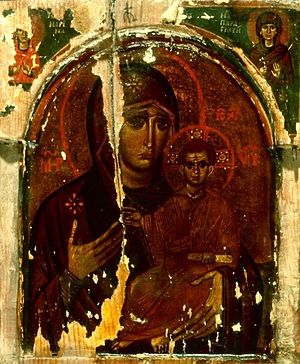 “Virgin Hodegetria” with Saints Marina and Paraskevi, from the Sinai collections Made incarnate of the Holy Spirit and the Virgin Mary, Christ entered this world through a painless birth as the only bearer of human nature uncompromised by either the earthly pleasure that arose from human disobedience, or its resultant pain, as Saint Maximos pointed out. Undergoing that death as God, to which He owed nothing as man, Christ’s sacrifice releases His followers from the tyranny of death forever .. as the sacrifices of His Saints protect us from all manner of evil, by His grace, when we call on them .. And as our own sacrifices, by that same grace, become its conduit to our loved ones.
“Virgin Hodegetria” with Saints Marina and Paraskevi, from the Sinai collections Made incarnate of the Holy Spirit and the Virgin Mary, Christ entered this world through a painless birth as the only bearer of human nature uncompromised by either the earthly pleasure that arose from human disobedience, or its resultant pain, as Saint Maximos pointed out. Undergoing that death as God, to which He owed nothing as man, Christ’s sacrifice releases His followers from the tyranny of death forever .. as the sacrifices of His Saints protect us from all manner of evil, by His grace, when we call on them .. And as our own sacrifices, by that same grace, become its conduit to our loved ones.
What enabled Saints Paraskevi and Catherine and young women like them to undergo trials we cannot bear to read about? To inspire hundreds of thousands to follow suit, on the path not of self-gratification, but of self-sacrifice, in unrestrained thanksgiving to the Lord of Glory?
Turning to the masterworks of Byzantine iconography, the inward gaze of the Saints upon eternity takes us closer to the answers. Given that the eye is the lamp of the body, as Christ said, the eyes of the sanctified, holding only to Christ, hold knowledge of the mysteries beyond contemplation. For, in the teaching of Saint Paul to the Hebrews, both the One sanctifying, and those being sanctified, are “of one.”
The magnetic gaze of the Saints – beyond tranquility, beyond the peace of this world – speaks a language whose fluency is commanded only by the soul. Indeed, as evinced by the massive crowds descending on the exhibits of Sinai icons in New York, Los Angeles, Moscow, Saint Petersburg, and other world capitals, it is the mind’s utter inability to pierce the mysteries of God that draws the soul ever closer to them.
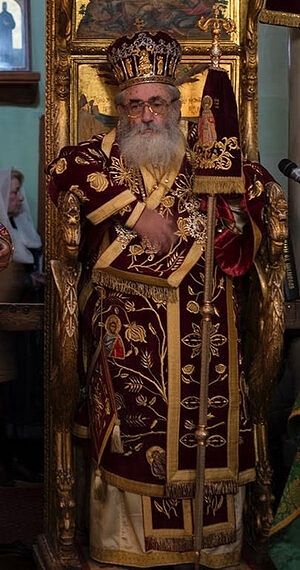 His Eminence, Archbishop Damianos I of Sinai nears completion of his fifth decade as spiritual leader of Christianity’s oldest monastic community and beloved spiritual father of numberless faithful The human soul in itself is an unsearchable mystery, observes His Eminence, Archbishop Damianos of Sinai. Just as Christ emptied Himself of divinity in order to suffer death, he noted, humans empty themselves of sin in order to take on divinity. “Through the patience and wisdom and other divine attributes bestowed on human nature by the Creator, the person striving for sanctification participates in the divine attributes of God,” he said.
His Eminence, Archbishop Damianos I of Sinai nears completion of his fifth decade as spiritual leader of Christianity’s oldest monastic community and beloved spiritual father of numberless faithful The human soul in itself is an unsearchable mystery, observes His Eminence, Archbishop Damianos of Sinai. Just as Christ emptied Himself of divinity in order to suffer death, he noted, humans empty themselves of sin in order to take on divinity. “Through the patience and wisdom and other divine attributes bestowed on human nature by the Creator, the person striving for sanctification participates in the divine attributes of God,” he said.
“Especially through patience, and increasingly so, as physical powers diminish with age. Patience assumes ever greater weight, until it becomes a form of violence, that with which ‘the violent seize the kingdom of heaven.’ ”
This is where the trials of the Martyrs leave us no excuse in facing our own, according to the next words of His Eminence:
“If you want to talk about the essence of holiness, this is where to look."
This is the “mystical theology” of the Orthodox Church: the soul’s grasp of that which is received from God alone. This is the source of the courage that thanks God, not with charades but with our honest, however small, sacrifices. The Fathers are clear: martyrdom is for the few. We are called to imitate their single-hearted love for God, not their physical feats, which are strictly for those called to them by God, as Father Pavlos said of monks and monasticism. Analogous with each one’s health and circumstances, the fasting customs of ancient Orthodoxy make it all easy. (Until, that is, the zealous faster’s culinary skills increase to the point that he impatiently awaits the upcoming fast in order to enjoy its delicious dishes!)
Saint Catherine and the other Martyrs whose young lives touch our own in so many ways – Marina was only fifteen – clearly understood what the age of technology struggles with: God is thanked not by grasping ever more of his gifts, but by sacrificing them to something so much higher than material pleasure that we have no name for it. What, then, is the experience that transcends the desires of the senses?
Without a doubt – the gift of God to the soul that single-heartedly seeks it.
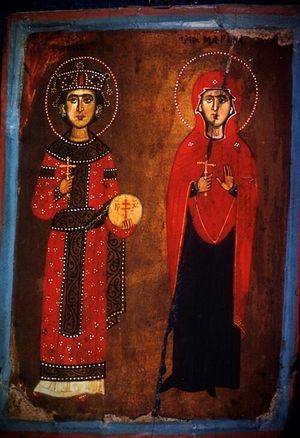 Saints Catherine and Marina, from the Monastery collections The light on Mount Sinai shines with incredible clarity, and the path to the Holy Summit is clearly marked. It gets breezy toward the top, and brisk winds try to blow the slight of stature right off the rocky steps. But no ambiguity clouds the ascent, and the same is true of the spiritual message that God descended on its heights to bestow on humankind, and that Saint Catherine emblazoned on all posterity in denouncing idolatry to the Roman emperor Maximian: You shall have no other gods before Me.…
Saints Catherine and Marina, from the Monastery collections The light on Mount Sinai shines with incredible clarity, and the path to the Holy Summit is clearly marked. It gets breezy toward the top, and brisk winds try to blow the slight of stature right off the rocky steps. But no ambiguity clouds the ascent, and the same is true of the spiritual message that God descended on its heights to bestow on humankind, and that Saint Catherine emblazoned on all posterity in denouncing idolatry to the Roman emperor Maximian: You shall have no other gods before Me.…
Putting the Savior first, not now and again, but on every occasion infuses life with all the genuine happiness it lacks, keeping in mind an important point: It is not our successes that unite us to the love He wishes to shower on us. It is rather the gratitude to God couched in our efforts to succeed that matter most, as Archbishop Damianos subtly pointed out when he said, “The person striving for sanctification participates in the divine attributes of God.” It is telling that he did not say “the sanctified person” participates in God … Greek is precise on such points, as was Saint Paul when he wrote that both the One sanctifying and those being sanctified are all of one.
How can sanctifier and the sanctified be one, asked Cyril of Alexandria – when God alone has the power to sanctify? Only in Christ is it possible, he answers, whose human nature, as the only perfect Man, is restored by His divine one from the effects of the fall.
Christ deifies His own human nature on behalf of all, so that humans can follow suit. But will mankind profit? Moved by a love for God too powerful to be muted by the passage of ages, Saint Catherine and the other Great Martyrs offer their lives – not only to God, but to us – as proof that simply putting love for God above the idols we make of food and drink, friendship and relatives, wealth and status and every other earthly pleasure, enables us to reach levels we never imagined – the ones for which we were created …
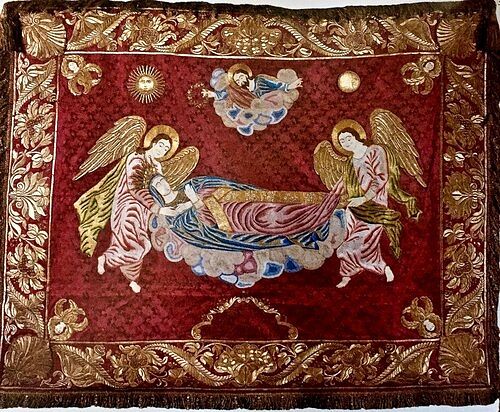 Sinai tapestry of Saint Catherine crowned as a Holy Martyr by Christ while being attended by Holy Angels
Sinai tapestry of Saint Catherine crowned as a Holy Martyr by Christ while being attended by Holy Angels
One need but start on his path, according to Saint John Klimakos, in order to find out where his efforts will take him. Something similar must have occurred when Saint Catherine, turning her intellectual powers inward to discern the truth of Christ, rose not only to the sacrifices of the Great Martyrs before her, but precipitated her own martyrdom, condemning idolatry not only with words, not only with sufferings, but above all, with her love for the truth. More than an act of bravery, the Saint imitates the Passion of Christ Himself in reversing the mistake of the first humans who chose material pleasures over delight in God.
For good reason we filled our cities and lives not only with the names of the Great Martyrs, but the message of their single-hearted devotion. For the light of no other answers our own deepest longings, couched in the commandment to prosper that thundered on humanity from the God-trodden Mountain of Sinai in the immortal words to love God, first….

